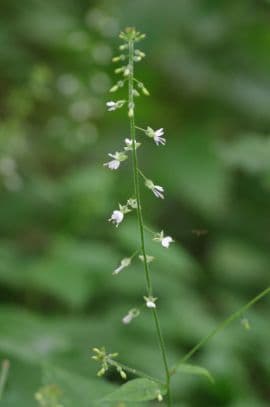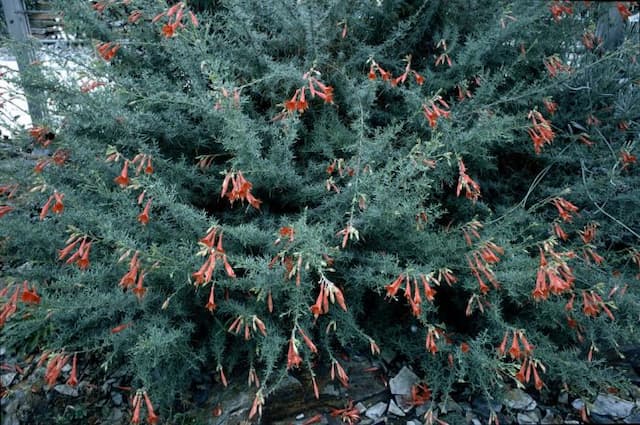Fuchsia Fuchsia 'Marcus Graham' (d)

ABOUT
Fuchsia 'Marcus Graham', known for its decorative blooms, showcases a delightful array of flowers that typically dangle from the plant like small, graceful chandeliers. Each flower is a spectacle of two-tone colors with a purple-pink outer layer known as the calyx, elegantly contrasted with the inner petals, which bloom into a rich, vivid purple hue. The petals are uniquely shaped, creating an almost dancer-like form that is visually striking against the backdrop of dark green foliage. The leaves themselves are oval, slightly elongated, with a subtle serration along the edges, contributing to the plant's lush and bountiful appearance. As the blooms hang from the branches, their distinctive bell-like shape and the contrast between the exterior and interior colors give the plant a look of festivity and exuberance. The overall presence of Fuchsia 'Marcus Graham' is one of elegance and vibrancy, with its cascade of pendulous flowers adding a burst of color and texture to any setting in which it is placed. It is favored by gardeners and plant enthusiasts for its ornamental value and the visual interest it adds to gardens and indoor spaces alike.
About this plant
 Names
NamesSynonyms
Marcus Graham Fuchsia, Lady's Eardrops, Hardy Fuchsia.
Common names
Fuchsia 'Marcus Graham'
 Toxicity
ToxicityTo humans
Fuchsia plants, including 'Marcus Graham', are generally considered non-toxic to humans. They do not possess any known toxins that could cause serious harm if ingested. Therefore, accidental ingestion of parts of the fuchsia plant typically does not result in poisoning or serious health consequences.
To pets
Similar to their effects on humans, fuchsia plants are also generally considered non-toxic to pets. This means that the 'Marcus Graham' fuchsia, like other fuchsias, should not cause serious harm or poisoning symptoms if pets happen to ingest parts of the plant. However, gastrointestinal upset is a possibility if a pet consumes a large amount of the plant.
 Characteristics
CharacteristicsLife cycle
Perennials
Foliage type
Deciduous
Color of leaves
Green
Flower color
Mixed
Height
1-2 feet (30-60 cm)
Spread
1-2 feet (30-60 cm)
Plant type
Shrub
Hardiness zones
9
Native area
Central and South America
Benefits
 General Benefits
General Benefits- Ornamental Appeal: Fuchsia 'Marcus Graham' adds visual interest to gardens with its decorative blossoms and attractive foliage.
- Hummingbird Attractor: The vibrant flowers are known to attract hummingbirds, bringing more wildlife into the garden.
- Shade Tolerance: This plant is suitable for shaded areas where other plants might not thrive, offering flexibility in garden planning.
- Container Gardening: It is well-suited for containers, allowing for versatile garden arrangements and the ability to move the plant as needed.
- Long Blooming Season: The plant has a long flowering period which ensures that the garden remains colorful for an extended time.
- Color Variety: Offers a range of colors through its flowers, which can complement a variety of garden designs.
 Medical Properties
Medical PropertiesThis plant is not used for medical purposes.
 Air-purifying Qualities
Air-purifying QualitiesThis plant is not specifically known for air purifying qualities.
 Other Uses
Other Uses- Fuchsia 'Marcus Graham' can be used in hanging baskets to create dynamic vertical gardens, adding depth and color to small outdoor spaces.
- Used as a living curtain, Fuchsia 'Marcus Graham' can provide a natural privacy screen for patios or balconies while offering visual interest.
- As a subject for botanical illustration, the distinctive flowers of the Fuchsia 'Marcus Graham' make it an excellent model for artists specializing in plant art.
- Fuchsia 'Marcus Graham' can be incorporated into educational settings, such as school gardens, to teach students about pollination and the lifecycle of plants.
- To create natural dyes, the petals of Fuchsia 'Marcus Graham' could potentially be used, although results may vary and experimentation is required.
- When dried and pressed, the colorful flowers of Fuchsia 'Marcus Graham' can be used in craft projects like creating greeting cards or bookmarks.
- The plant can serve as a unique living gift; for a housewarming or as a symbol of hospitality, reflecting the warmth of welcome with its bright blooms.
- Fuchsia 'Marcus Graham' can be used in garden-themed photography to provide a vivid pop of color against green backdrops, enhancing the composition.
- For culinary purposes, although not commonly known for edibility, petals might be used as a garnish for their ornamental value, after ensuring they are free from pesticides.
- As part of a hobby, enthusiasts can try their hand at hybridizing by crossing Fuchsia 'Marcus Graham' with other Fuchsia varieties to create new hybrids with unique characteristics.
Interesting Facts
 Feng Shui
Feng ShuiThe Fuchsia is not used in Feng Shui practice.
 Zodiac Sign Compitability
Zodiac Sign CompitabilityThe Fuchsia is not used in astrology practice.
 Plant Symbolism
Plant Symbolism- Confiding Love: In the Victorian language of flowers, fuchsia is associated with confiding love, making it a suitable gift between close friends and loved ones who share a deep bond.
- Good Taste: The elegant and vivid appearance of the fuchsia flower suggests a sense of good taste and sophistication, symbolizing someone who appreciates beauty and aesthetics.
- Trust: The hardy nature of the plant, along with the bell-like shape of its blossoms which seem to 'speak', has given it symbolic associations with trust and open-heartedness.
- Amiability: The fuchsia often symbolizes amiability and warmth, making it an excellent plant to give to someone who has a friendly and approachable personality.
- Elegance and Grace: The delicate hanging flowers of the fuchsia are often seen as a representation of elegance and grace, celebrating beauty and poise.
 Water
WaterFuchsias like 'Marcus Graham' need to be watered regularly and kept moist, but not waterlogged. During the growing season, water the plant thoroughly whenever the top inch of soil feels dry to the touch, which may be about twice a week. Decrease watering frequency in the winter when the plant is not actively growing. Each watering session should provide enough water to soak the soil deeply, which could mean using approximately 16-32 ounces for potted plants or 1-2 gallons for larger specimens in the ground, depending on the size of the plant and the environmental conditions. Avoid overhead watering to keep the delicate flowers and leaves from damage.
 Light
LightThe Fuchsia 'Marcus Graham' prefers bright, indirect light or dappled sunlight. Avoid harsh, direct afternoon sun, which can scorch the leaves and flowers. The best spot for this fuchsia would be in an area where it can receive morning sun and afternoon shade, or a location that gets filtered light through a canopy of taller plants or a sheer curtain if indoors.
 Temperature
TemperatureFuchsia 'Marcus Graham' thrives best in a temperature range of 55-75°F. The plant can survive minimum temperatures down to about 40°F, but frost can be detrimental, so it's important to bring it indoors or provide protection if the temperature approaches freezing. Ideal growing conditions would keep the plant consistently within the favorable temperature range, avoiding extremes on either end of the spectrum.
 Pruning
PruningPruning Fuchsia 'Marcus Graham' is crucial for encouraging a bushy growth habit and abundant blooms. Trim back the tips of the branches in early spring to promote branching and remove any dead or damaged wood. Pruning can be done again in midsummer if the plant becomes overgrown. The best time for major pruning is in late winter or early spring before new growth starts, though light shaping and deadheading spent flowers can be done throughout the growing season.
 Cleaning
CleaningAs needed
 Soil
SoilFuchsias prefer a well-draining soil mix composed of peat moss, perlite, and loam, with a pH between 6.0 and 7.0 for optimal growth.
 Repotting
RepottingFuchsias should be repotted every two to three years or when they become root-bound.
 Humidity & Misting
Humidity & MistingFuchsias thrive in high humidity levels, around 60-70%, which can be achieved with regular misting or a pebble tray.
 Suitable locations
Suitable locationsIndoor
Place in bright, indirect light and ensure high humidity.
Outdoor
Position in dappled shade, shelter from intense sun and winds.
Hardiness zone
9-11 USDA
 Life cycle
Life cycleFuchsia 'Marcus Graham' begins with seed germination, where the plant starts to grow from a seed, typically in warm, moist soil conditions. Following germination, it enters a vegetative stage, where the focus is on leaf and stem growth, establishing a robust root system. As it matures, it starts to develop distinctive drooping flowers that are a hallmark of fuchsias, and this flowering stage can last for an extended period, especially in favorable conditions. After pollination, often by hummingbirds or other pollinators, the plant produces berries (fruit) containing seeds, thus completing the reproductive cycle. In temperate regions, fuchsia may enter a dormant stage in the winter, where growth slows down or stops until favorable conditions return in spring. Throughout its life, Fuchsia 'Marcus Graham' may need pruning to encourage bushier growth and more prolific flowering.
 Propogation
PropogationPropogation time
Spring-Early Summer
The Fuchsia 'Marcus Graham', commonly known as fuchsia, is typically propagated through softwood cuttings. This method is most effectively done in spring to early summer when new growth is green and pliable. To propagate fuchsias, take a cutting of about 2 to 4 inches (5 to 10 cm) long, ensuring that it contains at least two sets of leaves. Remove the bottom leaves and dip the cut end in rooting hormone powder to encourage root development. Plant the cutting in a pot filled with a light, well-draining potting mix. Water the cutting thoroughly and then cover the pot with a plastic bag or place it in a propagator to maintain high humidity. Keep the pot in a warm place with indirect light and in a few weeks, the cutting should root and be ready to grow into a new fuchsia plant.









